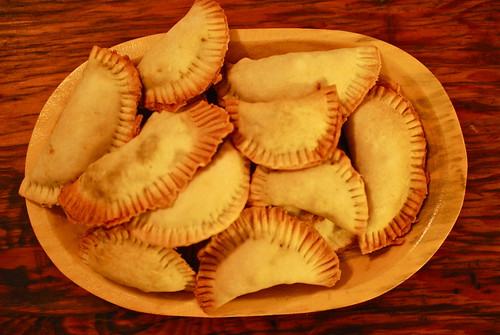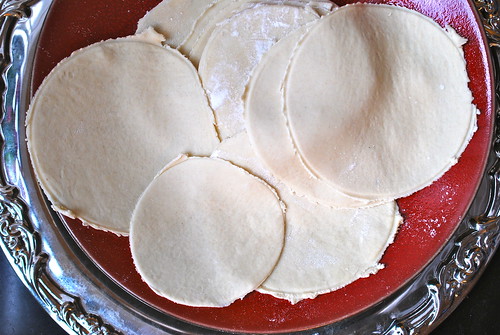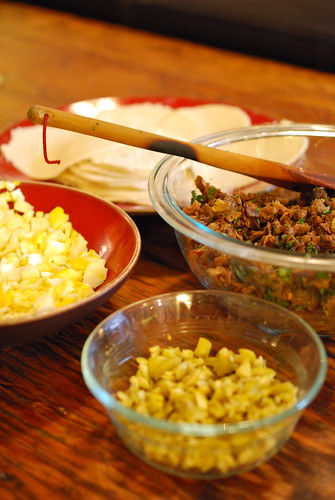Let’s talk empanadas.
Before we move on completely from Argentina, I think these delicious pockets deserve a shout out. We couldn’t get enough of them while we were in Argentina.
They come in so many forms and with countless fillings—some more bready, some crispy, some fried. Different regions each put their own spin on them. They’re perfect anytime of day. I was addicted.
(I should note that other Latin American countries have their own versions too. Venezuela also has delicious empanadas, although they’re a little different. I’ll share those one of these days, but that’s for another time.)
I was still feeling cravings for quite some time after we got back, so we hosted a small empanadas and Malbecs party. It was an excuse to try my hand at making the Argentine empanadas and share some of the wines we brought back, and have friends share some of their favorites in turn. It was intended as a happy hour style gathering, but it ended up running on into the night. Who can leave when there are empanadas to be eaten? But despite making a big batch, the wine kept flowing and outlasted the empanadas, so we all ended up a bit tipsy
As a souvenir, I got myself a copy of Francis Mallmann’s Seven Fires: Grilling the Argentine Way , and I used the recipe for Empanadas Medocinas as my guide.
, and I used the recipe for Empanadas Medocinas as my guide.
Incidentally, this is beautiful book filled with recipes that are clearly meant to simply showcase their ingredients. There are also some that show you a few tricks on how to dress up and refine traditional dishes. There are recipes in here for every level of ability. The directions are nicely detailed, as you’ll see in the recipe for empanadas below.
I didn’t change much at all when I made them at home other than to add some pimentón ahumado (smoked paprika) in addition to the sweet version called for here, and a little chili powder, because I like more heat in my food than the Arentine’s do.
The dough for these empanadas yielded a crispy, slightly cracker-like dough. The baked version was nice for a party, because I could bake them all off ahead of time and keep them warm or reheat them in the oven. Next time I’ll try frying them for experimentation’s sake. I would recommend making the meat mixture ahead of time, both to allow the flavors to meld and to split up the work.
I did play with the sizes just a bit. Cutting the dough into the 3½ inch circles suggested in the recipe made nice appetizer empanadas, but I found that slightly larger circles made a more satisfying portion. (For these I used a wide-rimmed glass.)
Mmmm. I might need to make these again soon. Suddenly feeling pangs of empanada cravings again.
Empanada Dough
A rolling pin is the traditional tool used for making empanada dough, but if you have a pasta machine, it makes the job easier. (I definitely used my pasta machine for this one.)
Salumera, water boiled with salt, is a seasoning solution often used in Argentine cookery. The proportions vary from chef to chef and recipe to recipe.
Ingredients
2 cups water
1 ½ Tbsps salt
3 ½ Tbsps high-quality lard, cut into pieces
6 to 7 cups all-purpose flour
1. For the salumera, bring the water and salt to a boil in a small saucepan over high heat. Add the lard and stir until it melts, then transfer to a large wide bowl. Allow to cool to room temperature.
2. Using your hand, gradually add 5 ½ to 6 cups of the flour, about 1 cup at a time, until you can gather the dough into a ball. Sprinkle with ½ cup flour on a work surface to prevent sticking and knead the dough, adding more flour until it will not absorb any more; you want a stiff, dry dough. Divide the dough in half, shape into disks, and wrap in plastic. Chill for at least 1 hour, or up to 24 hours. (The dough can also be frozen, well wrapped, for up to one month.)
Empanadas Mendocinas
Makes roughly 24 empanadas
Ingredients
1 pound well-marbled stewing beef, such as sirloin tip or tri-tip
Coarse salt and freshly ground pepper
10 Tbsps (1 ¼ sticks) unsalted butter
¼ cup high-quality lard
3 medium onions, quartered and very thinly sliced
1 Tbsp crushed red pepper flakes
1 Tbsp ground cumin
1 Tbsp pimentón dulce (sweet Soanish smoked paprika)
4 scallions, minced, white and green parts kept separate
2 Tbsps extra virgin olive oil
¼ cup fresh oregano leaves, coarsely chopped
3 hard-boiled eggs, coarsely chopped
½ cup pitted green olives, coarsely chopped
Empanada dough (see above)
1. Trim and discard any gristle from the meat, but leave the fat. With a sharp knife, chop the meat into 1/8-inch pieces. Transfer the meat to a bowl and season with salt and pepper.
2. Melt 6 Tbsp of butter and 1 Tbsp of the lard in a large skillet over medium-low heat. Add the onions and sauté until they are translucent, about 8 minutes; do not allow them to brown. Add the red pepper flakes, cumin, pimentón, and the white part of the scallions and sauté for 2 minutes more. Turn off the heat and stir in the scallion greens. Season to taste with salt and pepper.
3. Heat the olive oil in a large skillet over high heat. Brown the meat in batches, and spread the browned meat out on a tray, so it doesn’t steam. When all the meat is browned, combine in a bowl with the onion mixture, the remaining 3 Tbsps of lard, and the oregano. Adjust the seasoning, cover with plastic wrap, and chill until firm. (The filling can be made up to 1 day ahead.)
4. To assemble and cook the empanadas, cut one piece of dough in half; keep the other half covered with plastic until ready to use. With a rolling pin, roll the dough out on a floured work surface into a rectangle about 8 by 22 inches and 1/8 inch thick or less, or roll through pasta machine, starting on the widest setting and decreasing settings as you continue until the dough strips are 1/8 inch thick or less. On the floured surface, using a biscuit cutter or a water glass, cut the dough into 3 ½-inch circles; you should be able to cut 6 circles. Transfer the circles to a floured baking sheet and cover with plastic wrap. Repeat with the remaining dough.
5. Heat an horno de barro or home oven (gonna guess that you’re going with option 2) (with the racks positioned in the upper and lower thirds of the oven) to 350°F. Remove the filling from the refrigerator. Oil two large baking sheets.
6. Cut the remaining 4 Tbsps butter into small pieces, and set out a cup of water.
Lay a circle of dough in the palm of your hand. Place a heaping tablespoon of filling onto one half of the circle, leaving a 1/3-inch border, and top the filling with a pinch each of chopped egg and chopped olives and a dot of butter. With your finger or a pastry brush, moisten the edges of the dough with water, then fold the dough over the filling in a half-moon shape and pinch the edges together, forming pleats to seal the dough. Transfer to one of the oiled baking sheets. Repeat with the remaining dough circles and filling.
Alternatively:
Lay out the circles of dough in rows on a floured surface. Spoon the filling onto one half of each circle and top with egg, butter, and olives. Brush the edges with water, fold over as above, and press with the back of a fork to seal the edges. Transfer to the baking sheets.
Bake for 15 to 17 minutes, until lightly browned. Serve immediately.
Variation: Fried Empanadas
Fill a caldero or Dutch oven halfway (no more, or it may splatter or flare up later) with oil or lard and heat over medium-high heat. When a bit of test dough added to the pot is surrounded by a gentle stream of bubbles and you can hear it gently frying, the oil is ready (it should be about 375°F). If it is too cold, the empanadas will be greasy; if it is too hot, the crust will blister and be golden before the filling has warmed through. Don’t overcrowd the pot. Add the empanadas to the hot oil a few at a time and fry for 5 to 6 minutes, or until golden brown and crisp. Use a splatter screen, and be sure to let the oil return to frying temperature between batches. Transfer to paper towels to drain, and serve hot.
All photos taken by my hubby, Greg.















No comments:
Post a Comment